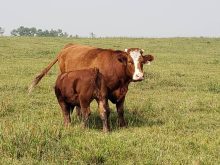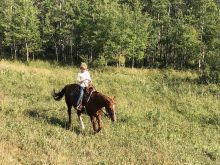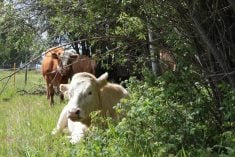There was an old saying on the trading floor — “Up the mountain; down the mountain.” After extreme highs; traders need to prepare for extreme lows. Earlier in summer, I thought the cattle markets would start to stabilize and maybe turn around in October. However, I have to eat my words because as of mid-October, fed and feeder markets continue to trend lower.
U.S. beef production has exceeded earlier projections and demand has been stagnating. Alberta packers were buying fed cattle in the range of $128 to $131 in late October, which was the lowest since December of 2013. At the same time, U.S. fed cattle were trading in the range of US$95 to U.S.$99. The last time prices were this low in the U.S. was 2010.
Read Also

Harvest wraps up and fall work begins
At the Eppich famly ranch in western Saskatchewan, the fall harvest was successful with few breakdowns, cows and calves have been sorted and a new tractor has arrived
After nearly 14 months of negative margins, feedlot operators are extremely risk-averse and replacements need to be bought accordingly. The market is in a period where the eyes begin to draw straws. Auction barns in central Alberta had 800-pound steers selling around $170 while 550-pound steers were quoted in the range of $175 to $180. I’ve received many calls asking “where is the bottom of this mountain?” Cow-calf producers are experiencing sticker shock as the large dose of reality sets in.
U.S. production way up
The 2015 U.S. calf crop was 800,000 head above 2014 and we’re likely going to see the 2016 calf crop finish nearly one million head above last year. U.S. cattle-on-feed inventories have been running one to two per cent above year-ago levels and we now find feedlot numbers the highest levels in three years. Placements in August were up nearly 15 per cent, which shouldn’t be a surprise. The industry is bracing for sharp year-over-year placement increases on subsequent reports.
The USDA increased its 2016 fourth-quarter beef production to 6.4 billion pounds, a year-over-year increase of 300 million pounds. In the first quarter of 2017, beef production is estimated at 6.1 billion pounds; however, second-quarter production could reach 6.5 billion pounds (relatively the same as in 2013). If you look at pork numbers too, overall red meat supplies could surge by a total of two billion pounds in 2017.
In Canada, year-to-date beef production for the week ending October 8 was running 11 per cent above year-ago levels or about 80,000 mt. Year-to-date beef and veal exports to the U.S. for the week ending August 31 were up 16 per cent or about 25,000 mt over last year. The market is functioning to encourage demand through lower prices.
Beef demand near saturation
It’s typical that retailers react slowly to declining prices but recent data is surprising. U.S. ground beef was selling on average for US$3.66/pound, the lowest since March of 2014. However, higher-end cuts remained near historical highs throughout the first half of 2016 and only started to ease in late summer. U.S. at-home food spending is running 4.8 per cent above year-ago levels while away-from-home food spending is up 7.8 per cent.
Beef demand appears to have reached a saturation point. Unemployment rates are near long-term lows and consumer confidence remains strong. Home appreciation has occurred on both sides of the border, but consumer debt levels are relatively high, especially in Canada. We are not seeing the strong seasonal swings as in past years.
The feeder cattle market has moved in line with fed cattle prices. Southern Alberta barley prices are off nearly $50/mt from last fall but the total costs per pound gain are only off about 10 cents a pound. It appears that the actual feed inputs are making a smaller portion of the overall costs of feeding cattle with factors such as labour making up a larger percentage. Cow-calf producers have delayed marketings this fall partially due to the adverse weather. I expect a sharper year-over-year increase in feeder numbers that will have to come on steam before the end of the year.
The feeder market in Western Canada continues to digest the Western Feedlots’ announcement to halt operations. I’ve mentioned to producers that this is a “black swan variable” that no one could forecast. Is this the tip of the iceberg or is this the case where if they could have hung on another month, the market would have turned around? I’ve seen many traders throw in the towel because they couldn’t make that last margin call, only to find out that was the absolute low of the market. To put prices in perspective, the June 2017 live cattle contract is within $14 of the 2009 recession lows. This may be the bottom of the mountain we’ve been looking for.
















